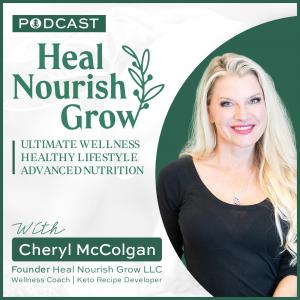Heal Nourish Grow Podcast

Foot Health to Combat Full Body Aches and Pains, Tips and Exercises
Dr. Emily Spichal, a functional podiatrist and human movement specialist, discusses the importance of foot health and the role of functional medicine and movement in podiatry. She shares her journey into this field and the development of her sensory-based product line, Naboso. Dr. Emily emphasizes the need for a holistic approach to foot health and the impact of footwear on foot function. She also explores the connection between foot posture, movement patterns, and overall body alignment, as well as the importance of foot health and its impact on overall posture and movement. She explains the benefits of using toe spacers to reset the feet and improve conditions such as bunions, hammer toes, and plantar fasciitis. Dr. Emily also emphasizes the role of sensory perception in foot movement and the importance of reconnecting with the sensory side of ourselves. Her new book is called Sensory Sapiens, which explores how modern movement is aging us and the need to prioritize movement longevity. She advises releasing the feet daily to reduce foot stress and pain. Connect with Dr. Splichal at her website and if you check out Naboso products here, use code HEALNOURISHGROW for 10 percent off. Kineon red light therapy for body pain was the other tool mentioned in this episode. After chatting with Dr. Emily, I bought the toe spacers as well as the sensory ball, I'm obsessed! Takeaways Foot health is an important aspect of overall well-being, and a holistic approach that considers factors like movement, stress, sleep, and diet is crucial. Functional podiatry focuses on treating feet in an integrated way, considering complex human movement and the sensory side of the foot. Footwear trends, such as the current maximalist shoe trend, can impact foot function and movement accuracy. Understanding foot posture and its effect on body alignment is essential for addressing movement patterns and preventing injuries. Setting a stable base by activating the foot tripod, externally rotating the hips, and connecting with the toes can improve foot function and overall body alignment. Toe spacers are an effective tool for resetting the feet and improving conditions such as bunions, hammer toes, and plantar fasciitis. Sensory perception plays a crucial role in foot movement and overall posture. Reconnecting with the sensory side of ourselves can unlock proper movement and support longevity. Dr. Emily's upcoming book, 'Sensory Sapiens,' explores how modern movement is aging us and the importance of prioritizing movement longevity. Releasing the feet daily can reduce foot stress and pain. Watch on YouTube: https://youtu.be/LMvMop1P71U Show Transcript: Cheryl McColgan (00:01.026)Hey everyone, welcome back to the Here and Learn, Grow podcast. Today, I'm already tongue twisting myself, because I'm already thinking about Dr. Emily's name, it's Dr. Emily Slickle. And we were just chatting before the podcast, I was hoping not to butcher that, but I think I got it right. So Dr. Emily, welcome. I am so excited to chat with you today about all things foot, because we have not had that subject on the podcast yet. And I think… what you're doing with the way that you treat people virtually and the products that you have brought to market to really help people with their foot health is pretty incredible. So all that being said, I would love for you to just kind of introduce yourself and tell us how you got into this line of work. Dr Emily (00:39.508)Of course, well, thank you for having me on Dr. Emily. I am a functional podiatrist. that's, to me, that's very important to have that distinction. So that means that I treat feet, but I treat feet in a very integrated way. think very much about complex human movement, but also stress, sleep, inflammation, diets, how do people breathe? So a lot of stuff that I bring into it, almost like functional medicine, functional movement into my podiatry.






 Visit Podcast Website
Visit Podcast Website RSS Podcast Feed
RSS Podcast Feed Subscribe
Subscribe
 Add to MyCast
Add to MyCast